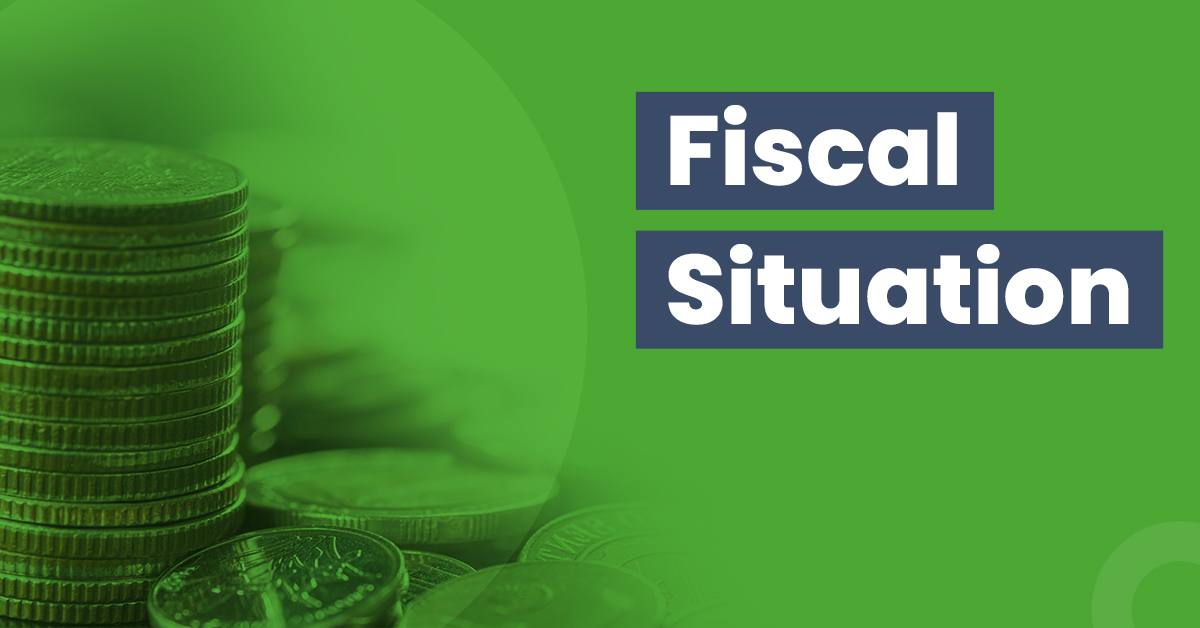Fiscal Situation of Union Government in 2022


The Union Budget for financial year 2022-23, presented by the Union Finance Minister Nirmala Sitharaman, was growth-oriented and pro-development. Its main aim was to set a pathway for making India a developed country over the next 25 years- the Amrit Kaal.
As per the budget estimates, the fiscal situation in this financial year is promising, despite the aftereffects of two successive Covid-induced economic slowdown. The nominal gross domestic product or GDP growth rate is estimated to be 11.1% in FY 2022-23.
Let’s see some more interesting facts related to India’s current fiscal situation.
Fiscal Analysis in Union Budget 2022-23
As per the budget document presented in the Parliament, the Indian economy’s projected growth in 2022-23 would be 9.2%. This is according to the budgetary estimates. The overall receipts of the government, apart from borrowings in FY 2022-23, is estimated to be ₹22,83,713 crore. The revenues or receipts have increased by more than 4% in FY 2021-22.
Now let’s focus on the deficit part of the Union budget. The projection of fiscal deficit in Budget 2022 for the ensuing financial year is 6.4%. This target or estimation aligns with the broader framework of fiscal consolidation that the government is trying to achieve.
However, the government will work to bring down this number to around 4.5% by 2025-26. It should be noted that the fiscal deficit target for 2022-23 is lower than revised estimates of fiscal deficit for the year 2021-22. The revised estimates for fiscal deficit in 2021-22 stood at 6.9% of the GDP.
In absolute terms, India’s fiscal deficit in 2022-23 could be around ₹15 lakh crore. Now that you are aware of the overall fiscal situation as enshrined in Union Budget 2022-23, let’s move on to get a deeper understanding of India’s fiscal situation in 2022.
Deficit Trend in Union Budget 2022
A deficit in the budget means that expenditure is higher than revenue generation of the government. In such a situation, it usually borrows from markets or the Reserve Bank of India to meet its expenditure.
There are three types of deficits that the government presents in the budget. These are primary deficit, revenue deficit, and fiscal deficit.
- The revenue deficit represents the difference between projected income and actual income of the government. It occurs when actual income is lower than estimated income.
- Fiscal deficit means the difference between total expenditure and total income. In other words, it represents the total borrowing needs of a government.
- Primary deficit is the difference between fiscal deficit and total interest payments.
The revenue deficit in the budget is estimated at 3.85% of the GDP. It is lower than revised estimates of the previous financial year, which stands at 4.7%. Moreover, the primary deficit in this budget was 2.8% which is comparatively lower than 3.3% in 2021-22.
What Are the Reasons behind Incurring Fiscal Deficit?
Fiscal deficit is the most important deficit parameter as it effectively tells us the borrowing requirements of the government for a particular year.
India is facing a high fiscal deficit in absolute terms due to several factors. Some of the reasons for incurring fiscal deficit are:
- Low revenue generation
The government’s tax and non-tax revenues faced substantial reductions due to economic slowdown during the Covid pandemic. Of course, other structural weaknesses are responsible for lower revenue generation, but pandemic-led slowdown accentuated this problem.
- High expenditure
India is a big country with a very large proportion of the population in the lower income group. Therefore, the government has to spend a large portion of its resources on providing basic services. As a result, it unnecessarily increases the burden on the exchequer.
- Structural weakness
The Indian economy has several inherent structural weaknesses, which makes it sustain on a low revenue base. Therefore, the government must work assiduously on structural reforms to make our economy more resilient and have a large revenue base.
- Tax evasion
This is another problem that our country has been facing since Independence. In India, the tax net is quite small as compared to its total population, and subsequent evasion of taxes by a section of the populace gives a major dent in the earnings of the government.
Revenue and Expenditure Trends in Union Budget 2022
Now, let’s consider the revenue and expenditure trends for the financial year 2022-23 according to the Union budget. The projection for total revenue expenditure in 2022- 23 is ₹31,94,663 crore which is slightly higher than the expenditure incurred in 2021-22, which stood at ₹31,67,289 crore.
Capital expenditure, which deals with the creation of capital assets, has been budgeted at ₹7,50,246 crore. This has been increased by nearly 24.5% when compared to the Union Budget 2021-22.
The estimated revenue receipts for 2022-23 will stand at Rs. 22,04,422 crore. It shows a 6% increase over revenue receipt that the government earned during 2021-22. Moreover, capital receipts as per budget document for the year 2022-23 is modest at ₹79,291 crore. However, it is expected to show a decline as compared to capital receipts earned in the previous financial year.
Taxation Trend as per Union Budget 2022
Tax revenues constitute an important component of a government’s fiscal policy. There are two kinds of tax revenues: direct tax revenues and indirect tax revenues. The gross total tax revenue estimation as per budget estimates for 2022-23 stands at Rs. 27,57,820 crore.
Budgetary estimate for corporation taxes and income tax, which constitute direct tax revenues, is standing at ₹14,20,000 crore. On the other hand, the budgetary estimate of indirect tax revenue for 2022-23, which includes GST, customs, excise duties, etc., is ₹13,30,000 crore.
Overall, the estimated gross tax revenue collections will increase by 9% from the previous year. The budgetary estimate for non-tax revenues in the current fiscal year is standing at ₹ 2,69,6551 crore, which is a decline of 14% from the revised estimates of the previous year.
Final Word
As seen from this article, India’s fiscal situation is making a turnaround after the economic slowdown witnessed due to COVID-19 pandemic. There are promising signs in the revenue generation segment. However, the government must remain wary of higher fiscal deficits, which will have a bearing on sovereign credit ratings by various financial institutions.
Frequently Asked Questions
What is the external debt to GDP ratio of India?
As per the RBI bulletin issued in June 2022, India’s total external debt to GDP ratio is $620.7 billion as of March 2022, which is an increase of $47 billion from March 2021. The debt to GDP ratio stood at 19.9%, lower than the 21.2% witnessed in March 2021.
What are some of the tax proposals mentioned in the Union budget 2022?
The government is continuously trying to overhaul our taxation system to make it more in sync with some of the most advanced and taxpayer-friendly systems experienced worldwide. For example, the government is planning to bring digital currencies under the tax net. Some other proposals include reduction in the minimum alternate tax rate for co-operatives, review of tariff simplification, custom exemptions, etc.
What was the main theme of Budget 2022?
Union Budget 2022 revolved around four key pillars: productivity enhancement, inclusive development, PM Gatishakti, and financing investments.






